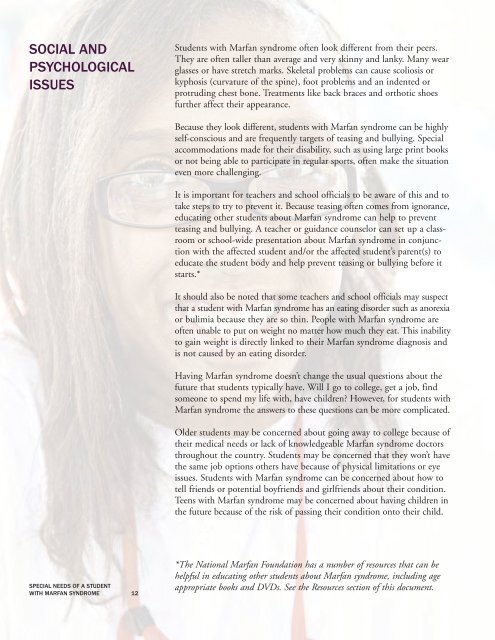Marfan Syndrome:
Marfan Syndrome:
Marfan Syndrome:
Create successful ePaper yourself
Turn your PDF publications into a flip-book with our unique Google optimized e-Paper software.
SOCIAL AND<br />
PSYCHOLOGICAL<br />
ISSUES<br />
SPECIAL NEEDS OF A STUDENT<br />
WITH MARFAN SYNDROME 12<br />
Students with <strong>Marfan</strong> syndrome often look different from their peers.<br />
They are often taller than average and very skinny and lanky. Many wear<br />
glasses or have stretch marks. Skeletal problems can cause scoliosis or<br />
kyphosis (curvature of the spine), foot problems and an indented or<br />
protruding chest bone. Treatments like back braces and orthotic shoes<br />
further affect their appearance.<br />
Because they look different, students with <strong>Marfan</strong> syndrome can be highly<br />
self-conscious and are frequently targets of teasing and bullying. Special<br />
accommodations made for their disability, such as using large print books<br />
or not being able to participate in regular sports, often make the situation<br />
even more challenging.<br />
It is important for teachers and school officials to be aware of this and to<br />
take steps to try to prevent it. Because teasing often comes from ignorance,<br />
educating other students about <strong>Marfan</strong> syndrome can help to prevent<br />
teasing and bullying. A teacher or guidance counselor can set up a classroom<br />
or school-wide presentation about <strong>Marfan</strong> syndrome in conjunction<br />
with the affected student and/or the affected student’s parent(s) to<br />
educate the student body and help prevent teasing or bullying before it<br />
starts.*<br />
It should also be noted that some teachers and school officials may suspect<br />
that a student with <strong>Marfan</strong> syndrome has an eating disorder such as anorexia<br />
or bulimia because they are so thin. People with <strong>Marfan</strong> syndrome are<br />
often unable to put on weight no matter how much they eat. This inability<br />
to gain weight is directly linked to their <strong>Marfan</strong> syndrome diagnosis and<br />
is not caused by an eating disorder.<br />
Having <strong>Marfan</strong> syndrome doesn’t change the usual questions about the<br />
future that students typically have. Will I go to college, get a job, find<br />
someone to spend my life with, have children? However, for students with<br />
<strong>Marfan</strong> syndrome the answers to these questions can be more complicated.<br />
Older students may be concerned about going away to college because of<br />
their medical needs or lack of knowledgeable <strong>Marfan</strong> syndrome doctors<br />
throughout the country. Students may be concerned that they won’t have<br />
the same job options others have because of physical limitations or eye<br />
issues. Students with <strong>Marfan</strong> syndrome can be concerned about how to<br />
tell friends or potential boyfriends and girlfriends about their condition.<br />
Teens with <strong>Marfan</strong> syndrome may be concerned about having children in<br />
the future because of the risk of passing their condition onto their child.<br />
*The National <strong>Marfan</strong> Foundation has a number of resources that can be<br />
helpful in educating other students about <strong>Marfan</strong> syndrome, including age<br />
appropriate books and DVDs. See the Resources section of this document.


